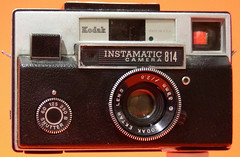Difference between revisions of "Kodak Instamatic 814"
(created page, with image.) |
|||
| Line 1: | Line 1: | ||
| − | |||
{{Flickr_image | {{Flickr_image | ||
|image_source= http://www.flickr.com/photos/thadeusmaximus/72109873/in/pool-camerapedia/ | |image_source= http://www.flickr.com/photos/thadeusmaximus/72109873/in/pool-camerapedia/ | ||
| Line 7: | Line 6: | ||
}} | }} | ||
| − | The '''Kodak Instamatic 814''' was a | + | The '''Kodak Instamatic 814''' was a coupled rangefinder camera for [[126 film|126 (Kodapak) film cartridges]] - one a large range of [[Instamatic]]s. It was made by [[Kodak]] in the US, between March 1968 and August 1970. A suprisingly heavy camera, it is well constructed and has a superb Ektar 38mm f/2.8 lens. A Tessar design, the lens contains thorium oxide and is, in fact, radioactive (one of many Kodak lenses from the 40's, 50's, and 60's that share this attribute). Film advance is via a spring motor drive that is wound by pulling on a long nylon strap that rewinds into the camera's bottom. |
Revision as of 02:29, 29 April 2008

|
The Kodak Instamatic 814 was a coupled rangefinder camera for 126 (Kodapak) film cartridges - one a large range of Instamatics. It was made by Kodak in the US, between March 1968 and August 1970. A suprisingly heavy camera, it is well constructed and has a superb Ektar 38mm f/2.8 lens. A Tessar design, the lens contains thorium oxide and is, in fact, radioactive (one of many Kodak lenses from the 40's, 50's, and 60's that share this attribute). Film advance is via a spring motor drive that is wound by pulling on a long nylon strap that rewinds into the camera's bottom.